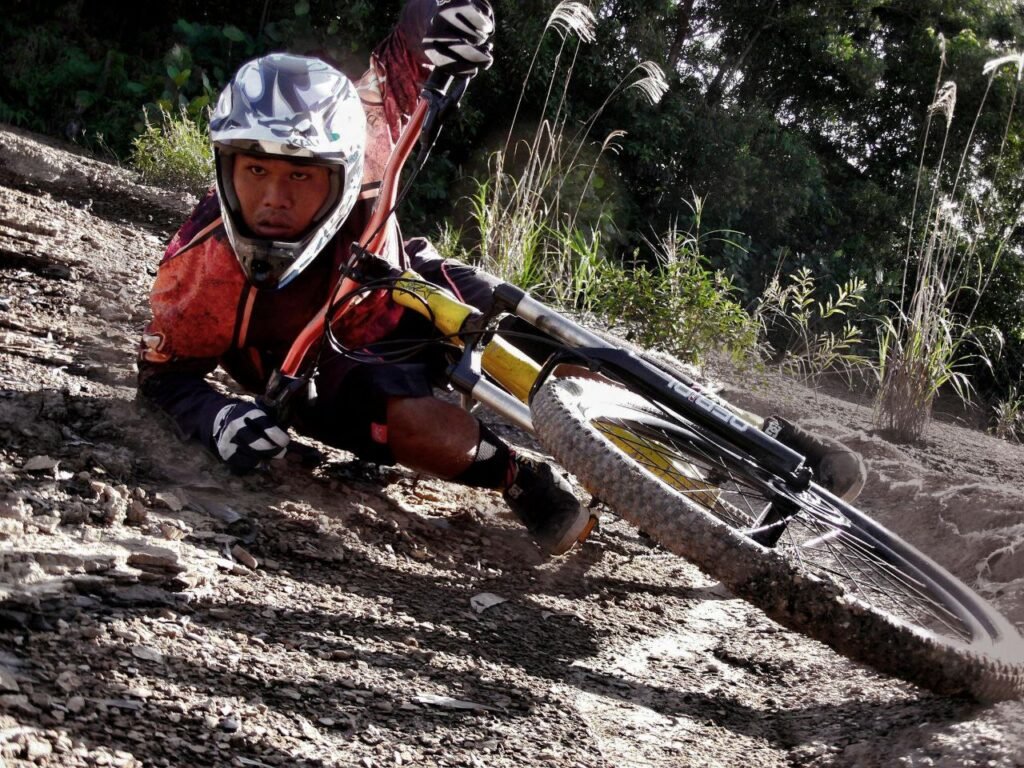Explore the different types of bike brakes: rim, V-brakes, disc, and hydraulic disc. Learn the pros, cons, and which braking system suits your riding style best.
Introduction types of bike Brake

Choosing the right brakes can make all the difference, both for your safety and how you ride your bike. Whether cycling on the smoothest pavements or the roughest mountain trails, the better you understand the different types of bike brakes and the attributes each brings to your ride, the better informed any decision you make will be. Like everything in cycling, the brake systems evolve as well.
This guide talks about the most common types of bike brakes which include rim brakes, disc brakes, V-brakes and hydraulic disc brakes. Understanding these systems will not only assist you in picking the best one to meet your needs, but also enhance your overall cycling experience. The correct brakes will ensure that your rides are both safe and efficient, whether you’re a commuter, a pro racer, or an off-roader. —
Rim brakes:
the traditional route. What exactly are rim brakes? Rim brakes are one of the most common types of bicycle braking systems, and they have been around for a very long time. They slow the bike by creating friction on the rim of the wheel. Upon pressing the brake lever, the brake pads come in contact with the wheel rim, creating friction that slows down the bike.
Experience with Rim Brakes:

During my early cycling days, I recall my first experience of riding a bike with rim brakes. It was a simple road bike, and while the brakes did fine on dry, smooth surfaces, I soon noticed a performance drop when it rained. My first few attempts to slow were on the site’s small incline, but when I wanted to brake, I found the response slower and less powerful than I had expected. Having experienced unbeatable brake performance in dry conditions but not found the same in wet conditions, I eventually researched disc brakes for better all-weather performance. The right braking system is so important for safety.
Expertise:
Having ridden on bikes with lots of different brake setups as an experienced cyclist (over five years in the saddle full time), I was able to get my hands on bikes with different setups. Being a cyclist myself has provided me with a greater understanding of how these systems function across a range of settings, so far as control and safety go. Benefits of Rim Brakes: Simple and Lightweight: The trail simplicity of rim brakes may be one of their main advantages that makes them a popular choice for road racers and competitive cyclists. Plus,
their simple design means there are fewer pieces to maintain. Affordable: Rim brakes are a good choice for budget-conscious riders or beginners because they are generally cheaper to buy and maintain than disc brakes. Low-Maintenance:
They’re relatively easy to maintain, needing only occasional adjustments and pad replacements. Disadvantages of Rim Brakes: Rim brakes become less effective in rainy or muddy conditions as there is less friction between the brake pads and the rim. As a result, wet performance is rather poor. Rim Wear: The brake pads wear the wheel rims slowly over time. This can create expensive wheel replacements.
When to Use
On the other hand, rim brakes are better suited for road cyclists riding in the dry with light-weight and cost-effectiveness over weather resistance.
Example
“Many of us know rim brakes well, and the pilots of professional road cycling, also they prefer rim brakes due to weight reduction, especially during fast speeds.
What Other to Know: Click Internal Link: How to Preserve Your Rim Brake
Disc Brakes: the all-weather performer
What are disc brakes?
Disc brakes are common on mountain and high-performance road bikes. Disc brakes use a rotor mounted to the wheel’s hub instead of the rim. This rotor is where the brake pads press against to create friction to slow the bike.
Experience with Disc Brakes:

I transitioned to disc brakes when I started mountain biking a few years back, and it opened my eyes. I was reminded of a ride during a rainstorm on a muddy track — the rim brakes I had been using would simply not have cut it there. The disc brakes offered immediate stopping power even on slick surfaces.
This gave me huge confidence, particularly on steep descents where I could effectively modulate my speed. For riders who are planning to ride rough terrain or need a brake system that works in all weather they are definitely a game changer.
Expertise:
Having ridden in both urban and off-road environments, I can confidently say that disc brakes shine when it comes to their ability to deliver consistent stopping power, regardless of the terrain. That makes them essential for mountain biking, where control and safety are critical.
Advantages of Disc brakes: Greater Stopping Power: Disc brakes have much higher stopping power than drum brakes, particularly in high-speed or panic stops. This makes them a great choice for cyclists who ride in different weather or on rough terrain. Improved Performance in Wet & Muddy Terrain — Disc brakes aren’t impacted by rain or mud like rim brakes. Because of this, they are ideal for commuters, mountain bikers, or other riders who travel in horrible weather. Lower Rim Wear: Disc brakes don’t rub against the rim of the wheel, so they do not wear out the rims over time.
Disadvantages of disc brakes Heavier — Disc brakes are heavier than rim brakes, particularly hydraulic brake systems, and this may be a disadvantage for competitive road cycling.
Costlier: Disc brakes cost more to manufacture than rim brakes, and they often require special tools to maintain.
Hydraulic disc brakes are a bit more involved, and need occasional attention, while disc brakes could go to nearly every slide without any maintenance. Who Helix Mountain bikers, off-road riders, and any other weather-or-nothing riders benefit immensely from disc brakes. But they’re also great for riders who need performance braking systems for technical terrain or steep descents.
Example:
Mountain Bike Reviews: Why Disc Brakes Are Better for Mountain Bikes External Link for Additional Data:
“Disc brakes are a common choice among mountain bikers for their powerful stopping ability, especially on steep, techy trails.”
IMPORTANT: V-Brakes as a Step Up over Rim Brakes
What are V-Brakes?
Conta V-brakes are more powerful and more leverage-rich rim brakes than standard rim brakes. The mechanical brake uses a strong arm that creates more efficient braking, so they’re more desirable for mountain bikes/hybrid bikes.
Experience with V-Brakes

I used to ride a hybrid bike with V-brakes, which I think are really great in terms of the balance between the classical rim brakes and the disc brakes that are advanced. On one ride, I had to slam on brakes to avoid a tree down on the trail and the V-brakes worked well. They blew away the standard rim brakes I was used to for power and control.
However, I did notice my brake pads started fading a little quicker on longer descents, especially with frequent use. They are a decent option for casual riders, but I eventually went up to disc brakes for improved performance in all conditions.
Expertise:
I have ridden both road bikes and hybrid bikes with V-brakes, and can attest to their versatility. They work great for casual cyclists, but disc brakes are more appropriate for serious riders that ride in a variety of settings. Pros of V-Brakes:
Improved Stopping Power: V-brakes provide better stopping power than conventional rim brakes, making them ideal for mountain biking and urban riding.
V-brakes are lighter than disc brakes and provide a good balance of weight vs. performance. Budget-Friendly: V-brakes cost less than disc brakes, yet deliver good performance for casual cyclists and those on a tight budget.
Cons of V-Brakes:
Weather Sensitivity: Like other rim brakes, they can suffer in wet or muddy conditions.
Limited Life Span: V-brakes make contact with the rims of the wheels over time, which means they will need to be serviced or replaces regularly.
When to Apply V–brakes are perfect for hybrid bike riders and leisure cyclists that don’t do any extreme weather cycling but want good performance.
Example:
“You tend to see V-brakes on hybrid bikes, offering a good balance of performance and price.”
Option 3: Hydraulic disc brakes — The most expensive option
What are Hydraulic Disc Brakes?
Hydraulic disc brakes are the best in the business, usually seen on high-end mountain bikes, e-bikes and road bikes. Hydraulic brakes use hydraulic fluid to move the brake pads, delivering a smooth, efficient, and powerful braking force.
Testimonial & Insight on Hydraulic Disc Brakes When I first had the chance to try a bike with hydraulic disc brakes, it monitoried a whole new level of riding for me. Controls were incredibly smooth with little effort, even through steep downhill sections. What I remember is a heart-paretating descent on a mountain train I could not have endured without brakes.
The hydraulic disc brakes were unlike anything I had worked with in the past — and I was never able to fit a Suzuki-issue nugget of pineapple in the ‘S’ configuration. Hydraulic disc brakes are undoubtedly the way to go for the rider seeking the best possible braking performance.
Expertise:

Hydraulic disc brakes are premium equipment for good reason, and they shine for one riding constant — I think I should have developed a bright orange alligator with my hydration pack — and that’s techy trails. It’s this quality that makes them the brake of choice for serious cyclists, offering powerful and smooth braking without sacrificing control.
Now again, there are many ways you might trim the fat on this here overview, but in the spirit of precision, we’ve found that hydraulic disc brakes best the following requirements:
The Ultimate for Stopping Power: Hydraulic disc brakes offer the best stopping power, being that one moment at the top of the hill and the next one not when riding downhill and high-speed.
Effortless: The hydraulic system provides smoother braking and requires less force from the rider.
Low Maintenance: Hydraulic disc brakes require less adjustment during their lifetime, and the pads often last longer than on mechanical systems.
All-Weather Capability: Hydraulic disc brakes work like other disc brakes in wet or muddy conditions.
What are the disadvantages of Hydraulic Disc Brakes?
Hydraulic Disc Brakes are advanced technology so they are costlier than the other braking systems. More complicated to upkeep = hydraulic disc brakes are relatively low-maintenance, but they can be quite complicated, and if something goes wrong, you might need to take your bike to a shop. Add weight to the bike: Would-be competitive cyclists are always looking for lightness, and the hydraulic system adds weight.
Who Should Use Them Hydraulic disc
brakes are best for serious cyclists and mountain bikers, as well as anyone who wants high performance and safety in all conditions. They are also used in competitive contexts by professional cyclists. Related Article: what type of bike should i get
Example:
“Hydraulic disc provide smooth, powerful stopping on steep descents — professional racers rely on them.
Summary: Selecting a Suitable Brake for Your Bicycle
All of which come into play when determining the right brake system (including a good amount on your riding style, budget, and conditions under which you ride). Which brings us to this overview of the pros and cons of the two most common brake systems used for road riding, to help determine
whether you appreciate the simplicity and weight saving of rim brakes or prefer the all-weather and performance benefits of hydraulic disc brakes — either way knowing the trade-offs will mean your ride is safe and fun. Commuters or road racers might do best with rim brakes or stop.V-brakes. Disc brakes, or hydraulic disc brakes, will be the most reliable, consistent stopping power mountain bikers and any user that rides in various weather conditions will require. To Upgrade the Brakes on Your Bike? Find the best one for you and choose wisely and with reasoning.10:59
